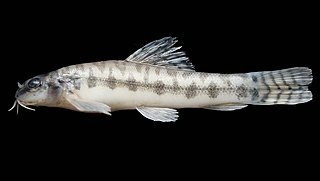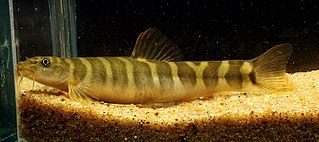
The Burmese Border loach, angelicus loach or polka dot loach, Botia kubotai, is a recently described species that has quickly become a popular tropical fish for freshwater aquariums. In 2002, fish collectors working in western Thailand began to expand their search into Myanmar (Burma) area from the Three Pagodas Pass Thai-Myanmar border to look for new fish for the aquarium trade. This is one of several species discovered and explains the origin of the fish's common name: Burmese Border Loach. Its specific epithet honors Katsuma Kubota of an aquarium export company in Thailand who first purchased the catch and sent them out for identification.
Acanthocobitis is a genus of freshwater ray-finned fish of the stone loach family, Nemacheilidae. Recent work has suggested that the genus be split into two with the former subgenus Paracanthocobitis being raised to a full species, leaving just the type species, Acanthocobitis pavonacea, in the current genus.

Schistura is a genus of fish in the stone loach family Nemacheilidae native to the streams and rivers of the southern and eastern Asia. Some of these species are troglobitic.
Acanthocobitis pavonacea, also known as the spearfin loach, is a species of ray-finned fish belonging to the family Nemacheilidae, the stone loaches. This species is found in the Brahmaputra River ofAssam. This is one of two species in the genus Acanthocobitis, alongside the type species, A. longipinnis. A. longipennis was treated as synonym of this species but in 2021 Maurice Kottelat and Waikhom Vishwanath published a paper that argued that A. longipennis was a valid species and that it was one of two species ofloach in the genus Acanthocobitis, alongside A. pavonacea, with the other species being classified in the genus Paracanthocobitis. This species is the type species of the genus Acanthocobitis.
Physoschistura is a genus of fish in the family Nemacheilidae found mostly in Southeast Asia.

Paracanthocobitis is a genus of freshwater ray-finned fishes belonging to the family Nemacheilidae, the stone loaches. This genus is known from the Indus basin in Pakistan to the Mekong basin of Cambodia and Laos The type species is Paracanthocobitis zonalternans. Some authorities treat this as a subgenus of Acanthocobitis

Paracanthocobitis mooreh also known as the Maharashtra zipper loach is a species of ray-finned fish in the genus Paracanthocobitis. This species is found in the Godavari, Krishna, and Kaveri basins of western and southern India.

Paracanthocobitis urophthalma, also known as the banded mountain zipper loach, is a species of ray-finned fish in the genus Paracanthocobitis. This species is endemic to southwestern Sri Lanka.

Paracanthocobitis zonalternans also known as the dwarf zipper loach is a species of ray-finned fish in the genus Paracanthocobitis. This species is known from Bangladesh, Myanmar, Thailand, and peninsular Malaysia. It is found in the Brahmaputra, Meghna, Irrawaddy, Sittang, Salween, Maeklong, and drainages in peninsular Thailand and Malaysia. The range extends from northern Myanmar to peninsular Malaysia. It is not known from the Chao Phraya basin.
Paracanthocobitis abutwebi also known as the hillstream zipper loach is a species of ray-finned fish in the genus Paracanthocobitis. This species is known from the Karnaphuli, Meghna, and lower Brahmaputra and Ganges river drainages of Bangladesh.
Paracanthocobitis adelaideae also known as the checkerboard zipper loach is a species of ray-finned fish in the genus Paracanthocobitis. This species is known from the Irrawaddy basin of northern Myanmar.
Paracanthocobitis canicula also known as the houndstooth zipper loach is a species of ray-finned fish in the genus Paracanthocobitis. This species is known from the lower Mekong basin of Cambodia.
Paracanthocobitis linypha also known as the sewing needle zipper loach is a species of ray-finned fish in the genus Paracanthocobitis. This species is known from the Irrawaddy and Sittang basins in Myanmar.
Paracanthocobitis maekhlongensis also known as the Maekhlong zipper loach is a species of ray-finned fish in the genus Paracanthocobitis. This species is known from the Maeklong River basin, Kanchanaburi Province, Thailand.

Paracanthocobitis botia also known as the mottled zipper loach is a species of ray-finned fish in the genus Paracanthocobitis. This species is known from the mainstem, and possibly tributaries of the Brahmaputra River, in Assam, India.
Paracanthocobitis mackenziei also known as the robust zipper loach is a species of ray-finned fish in the genus Paracanthocobitis. This species is the most widely distributed species of Paracanthocobitis and is known from the Ganges River basin of Nepal and India, the Meghna River basin in Bangladesh, the Mahanadi River basin in eastern India, and the upper Indus River basin of northern India and eastern Pakistan. Fishbase treats P. (A). mackenziei under Nemachilus mackenziei as a synonym of Acnthocobitis botia.
Paracanthocobitis mandalayensis also known as the Mandalay zipper loach is a species of ray-finned fish in the genus Paracanthocobitis. This species is known from the Irrawaddy drainage of northeastern Myanmar, Sittang basin of southern Myanmar, and the Wang and Ping rivers in the Chao Phraya River basin of northwestern Thailand.
Paracanthocobitis rubidipinnis also known as the cherryfin zipper loach is a species of ray-finned fish in the genus Paracanthocobitis. This species is known from the Irrawaddy basin in Myanmar.
Paracanthocobitis aurea also known as the barred zipper loach is a species of ray-finned fish in the genus Paracanthocobitis. This species is known only from the type locality, the Narmada River at Jabalpur, state of Madhya Pradesh, India.
Acanthocobitis longipinnis is a species of freshwater ray-finned fish belonging to the family Nemacheilidae, the stone loaches. This species is known from a single specimen, the holotype, which was collected from the Ganges. This species was first formally described in 1861 by the German naturalist and explorer Wilhelm Peters and Peters proposed the new genus Acanthocobitis. Later authors treated this species as a synonym of Cobitis pavonacea but in 2021 Maurice Kottelat and Waikhom Vishwanath published a paper that argued that A. longipennis was a valid species and that it was one of two species of loach in the genus Acanthocobitis, alongside A. pavonacea, with the other species being classified in the genus Paracanthocobitis. This species is the type species of the genus Acanthocobitis.





